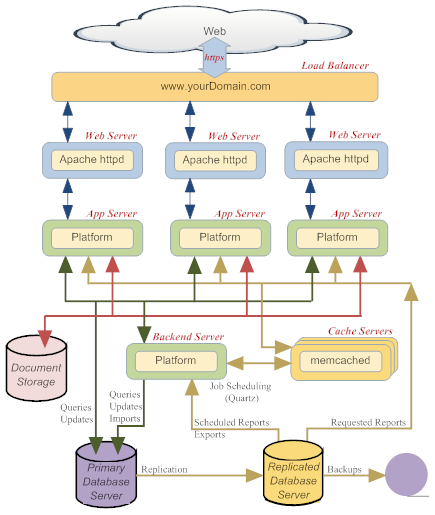Prototype Deployment
From LongJump Support Wiki
Prototype Deployment
The following diagram shows the kind of architecture that is typical for a production system:
The key points depicted in the diagram are:
- The platform is deployed across multiple servers.
- A Load Balancer distributes traffic across the web servers.
- Apache httpd is the front-end web server for the application server.
Learn more: Installing and Configuring Apache for Use with the Platform - Memcached servers reduce response time by caching data in memory.
Learn more: Configuring memcached - The suite of memcached servers are accessed by all application servers, backend as well as front end.
- The critical backend processes shown here (import, export, and scheduling, which uses quartz) are all being run from a single platform instance. But additional servers can be employed, as load demands.
Learn more: Managing Backend Services - Document storage (which includes pictures and image files) is managed separately from the database.
- The database is running on its own server, for added performance.
Learn more: Configuring MySQL to Run on a Separate Server - The primary database instance and the replication instance are each running on separate servers, both for reliability and for performance of read-intensive operations.
Learn more:
- Using Replication with Different Master and Slave Storage Engines
http://dev.mysql.com/doc/refman/5.5/en/replication-solutions-diffengines.html
- Requests that access and update, whether coming from a user or a backend process, go to the primary database, while read-intensive operations (backups, reports, exports) are executed on the replicated database.
Learn more: Running Reports and Storage Checks On a Replicated Database Server.
